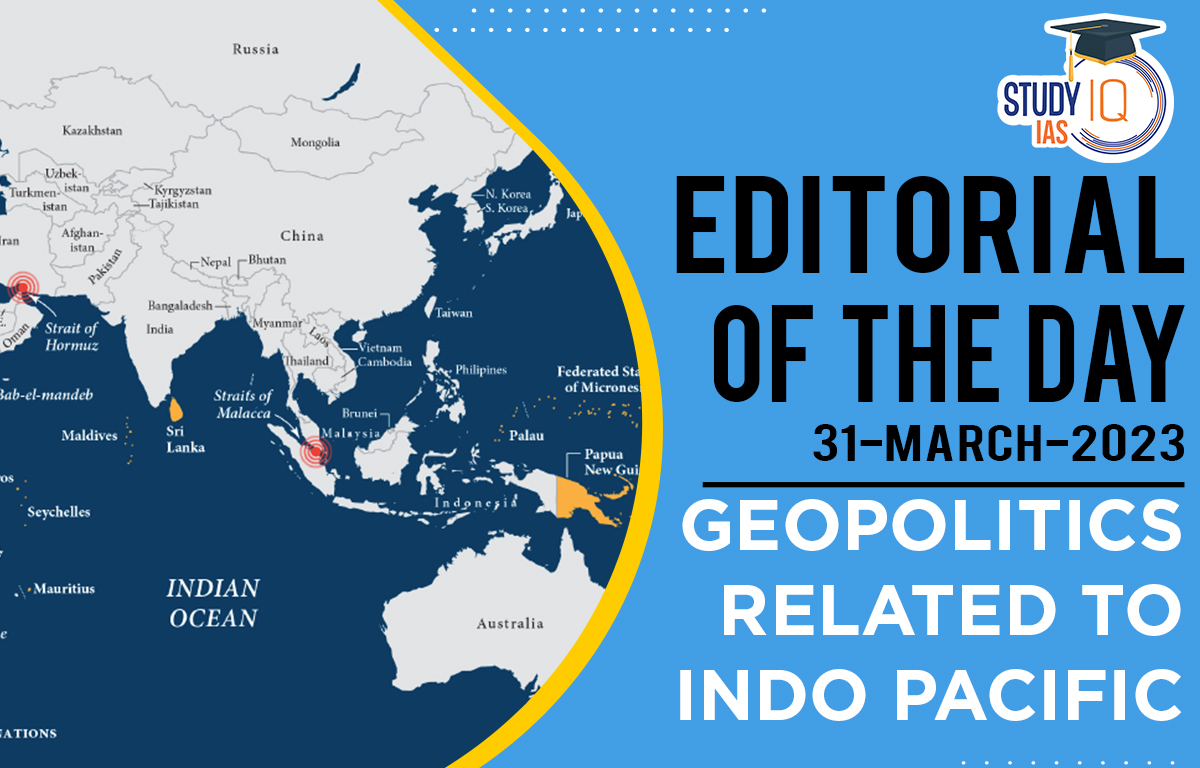Table of Contents
Context: In recent years, the term “Indo-Pacific” has gained increasing attention in international relations and security discussions as the region reflects the growing importance of its economic and strategic significance, particularly as the global balance of power shifts towards Asia.
What is the Indo Pacific Region?
- The Indo-Pacific region is a vast area that encompasses the Indian Ocean, the western and central Pacific Ocean, and the seas connecting them.
- It is a geopolitical construct that substituted the term “Asia-Pacific”. It covers the area from Africa’s east coast till America’s west coast encompassing the Indian and the Pacific Oceans.
- Major stakeholders in the Indo-Pacific: QUAD (India, U.S.A., Australia, Japan), Association of Southeast Asian Nations (ASEAN) members, China, and other maritime nations that occupy strategic positions in the Indian and the Pacific Ocean region.

Geopolitics in the Indo Pacific
- Geopolitics in the Indo-Pacific region is the interplay between geography, politics, and power for its strategic significance with the world’s busiest shipping lanes, key sea lines of communication, and valuable natural resources.
- Geopolitical dynamics in the region are complex and multifaceted with competing interests among major powers such as the United States, China, Japan, India, and Australia, as well as other regional powers like Russia, South Korea, and Indonesia driven by security, economic factors,, cultural ties, historical relationships, and domestic politics.
- The major issue in this region is the competition for power and influence between the United States and China, known as the “Thucydides trap”.
- This refers to the historical pattern of conflict that arises when a rising power challenges a dominant power.
- This competition is playing out in various ways, including through military buildups, economic initiatives such as China’s Belt and Road Initiative, and diplomatic efforts such as the Quadrilateral Security Dialogue (QUAD), that brings together the United States, Japan, India, and Australia.
- Other important geopolitical issues in the region include territorial disputes in the South China Sea.
Significance of the Indo-Pacific
The Indo-Pacific region is a critical area of global significance due to its large population, vast economic output, and abundance of natural resources. The region’s significance can be discussed in the following dimensions:
- Economic: The Indo-Pacific region is one of the most dynamic and vibrant economic regions in the world, accounting for a significant portion of global GDP and trade.
- The region is home to several of the world’s largest economies, including the United States, China, Japan, India, and Australia, as well as many emerging economies.
- The region is also a major destination and source of foreign direct investment (FDI) due to its sizeable consumer market, strategic location, and competitive labour costs.
- The region’s trade links and integration have been boosted by various initiatives, including the Regional Comprehensive Economic Partnership (RCEP), the Comprehensive and Progressive Agreement for Trans-Pacific Partnership (CPTPP), and the Belt and Road Initiative (BRI).
- Security: The Indo-Pacific region is also a critical area for global security, given its strategic location and the presence of various security challenges.
- The region is home to some of the world’s busiest shipping lanes and crucial sea lanes of communication, making it a crucial hub for global trade and energy flows.
- The region also faces a range of security challenges, including territorial disputes, piracy, terrorism, cyber threats, and non-traditional security challenges such as climate change, pandemics, and environmental degradation.
- Environmental dimension: The Indo-Pacific region is home to some of the world’s most diverse and fragile ecosystems, including coral reefs, mangroves, and rainforests.
- However, the region is also facing various environmental challenges, including climate change, ocean acidification, pollution, and overfishing. These challenges not only pose significant environmental risks but also have economic and social implications for the region’s communities, including those dependent on fisheries and other natural resources.
- Geopolitical dimension: The Indo-Pacific region is also characterized by complex geopolitical dynamics, including competition and cooperation among major powers, such as the United States, China, and India, as well as various regional groupings such as ASEAN and the QUAD.
- The region is also a site of various territorial disputes, including in the South China Sea and the East China Sea.
- These geopolitical dynamics have implications for the region’s security, stability, and economic development.

Geopolitical Interest of Nations in the Region
The Global powers and their geopolitical interests in the Indo-Pacific region:
- United States: The United States considers the Indo-Pacific region a priority area for its foreign policy, with the goal of maintaining a free and open Indo-Pacific that is conducive to American interests.
- The US has significant security interests in the region, including maintaining freedom of navigation, countering Chinese assertiveness, and ensuring regional stability.
- The US also seeks to deepen economic ties with the region, including through the Comprehensive and Progressive Agreement for Trans-Pacific Partnership (CPTPP) and the Blue Dot Network initiative.
- China:
- At the heart of China’s interests in this region is its “nine-dash line” claim, which asserts its territorial claims over much of the South China Sea, including islands and reefs that are also claimed by other countries in the region.
- This has been a major source of tension in the region, with other countries such as Vietnam, the Philippines, Malaysia, and Brunei also claiming parts of the sea.
- In addition to this, China has invested heavily in infrastructure development in these areas through initiatives such as the Belt and Road Initiative, which aims to connect China to other parts of Asia, Europe, and Africa through a network of roads, railways, ports, and other infrastructure projects.
- China also seeks to counter US influence in the region and assert its own vision of regional order.
- India: India has significant economic and security interests in the Indo-Pacific region, including countering Chinese assertiveness, expanding economic ties with ASEAN and other partners, and ensuring regional stability.
- India is a key member of the QUAD, which aims to promote a free and open Indo-Pacific, and has also pursued initiatives such as the Act East Policy and the International Solar Alliance to deepen ties with the region.
- Japan: Japan seeks to counter Chinese assertiveness, deepen economic ties with the region, and promote regional security and stability.
- Japan is a key member of the QUAD and has also pursued initiatives such as the Partnership for Quality Infrastructure and the Free and Open Indo-Pacific Strategy to promote its interests in the region.
- Australia: Australia is a key member of the QUAD and has also pursued initiatives such as the Pacific Step-Up and the Indo-Pacific Endeavour to deepen its engagement with the region.
- ASEAN countries: The ASEAN has also pursued initiatives such as the ASEAN Outlook on the Indo-Pacific to promote its own vision of regional order.
Conventions Related to Indo-Pacific Region:
There are several laws and conventions related to the Indo-Pacific region that include:
- United Nations Convention on the Law of the Sea (UNCLOS): This is a global treaty that sets out the rules for the use and management of the world’s oceans and their resources. The Indo-Pacific region is home to many countries that have signed and ratified UNCLOS, including China, Japan, India, and Australia.
- ASEAN Charter: The ASEAN Charter is a legal framework that governs the operations and decision-making processes of the Association of Southeast Asian Nations (ASEAN). ASEAN is a regional organization that includes ten member countries in Southeast Asia, and it plays an important role in promoting peace, stability, and economic cooperation in the Indo-Pacific region.
- Joint Communique of the United States-India Defense Ministers Meeting: This joint communique was signed in 2020 between the defence ministers of the United States and India. It sets out a framework for cooperation in the areas of defence, security, and strategic partnership between the two countries in the Indo-Pacific region.
- Quadrilateral Security Dialogue (Quad): The Quad is an informal strategic forum that includes the United States, Japan, India, and Australia. The Quad aims to promote regional security, economic development, and freedom of navigation in the Indo-Pacific region.
India and the Indo Pacific
Significance of Indo Pacific for India
- Economic:
- According to WEF’s recent report, this region generates one-third of global economic output, more than any other region.
- According to the WTO, this region accounts for more than one-third of global foreign trade.
- Maritime Resources:
- The blue economy contributes over 4% of India’s GDP.
- Various resources like oil, gas, PMNs and methane hydrates, exploration of rare earth metals, etc., make Indo-Pacific necessary for India’s interests.
- Maritime Trade:
- Half of the global trade transits the region, and 90% of India’s trade passes through the Indo-Pacific region.
- Nearly 55% of India’s trade with the Indo-Pacific region passes through the South China Sea.
- ASEAN, China, Japan, USA, and Australia, etc., are India’s major regional trade partners.
- Trade with major Indo-Pacific economies reached $262 billion in 2020, with the US being the largest trade partner. Strategic
- Maritime Security:
- Factors like sea-borne terrorism, maritime piracy, maritime disputes, and flashpoints like the South China Sea (SCS) in the Indo-Pacific make it an important region to ensure Maritime Security.
- The Africa outreach:
- The Western Indian Ocean Region (WIOR) is a region of greater strategic importance as WIOR sits at the intersection of Asia, Africa, and Europe.
- For India, the region is part of its strategic maritime frontier which extends from the Persian Gulf to the East coast of Africa and across the Malacca Strait.
- The strategic maritime chokepoints such as the Gulf of Aden, Bab-el-Mandeb, and Mozambique Channel are located here.
- The Indo-Pacific region runs parallel to India’s increasing outreach to African countries and supports the Indian Navy’s role as a regional security partner.
- The China Challenge: China’s ambitious military plans and infrastructure initiatives under the Belt and Road Initiative (BRI) and its border skirmishes demand India to look for a greater role in the Indo-Pacific region.
Challenges for India in the Region
- Geo-Strategic Competition: Indo-Pacific is the principal theatre of geo-strategic competition between different multilateral institutions like QUAD and Shanghai Cooperation Organisation (SCO).
- China’s Radical Militarization: China has been a challenge to India’s interests and stability in the Indian Ocean. India’s neighbours are receiving military and infrastructural assistance from China, including submarines for Myanmar, frigates for Sri Lanka, and its overseas military base in Djibouti (Horn of Africa).
- China also has a hold over Hambantota port (Sri Lanka), which is just a few hundred miles off the shores of India.
- Hotspot For Non-Traditional Issues:
- The region’s vastness makes it difficult to assess and address multiple risks, including incidents of piracy, trafficking and terrorism.
- The Indo-Pacific region is facing serious challenges related to geographical and ecological stability due to climate change and the three consecutive La Niña events that are causing cyclones and tsunamis.
- Illegal, unregulated and unreported (IUU) fishing and marine pollution is hampering the aquatic life of this region.
- India’s Limited Naval Capacity: Indian Navy has limited resources and capacity to strengthen its efforts because of limited allocation of Indian military budget. Also, lack of overseas military bases creates a fundamental logistical challenge for India to maintain its presence in the Indo-Pacific.
India’s Initiatives to fully Utilize the Potential of the Indo Pacific
- The Ministry of External Affairs established a new Division for the Indo-Pacific in April 2019.
- Indo-Pacific Oceans’ Initiative (IPOI): Its focus is on a collaborative effort to better manage, conserve, sustain and secure the maritime domain.
- It envisages this cooperation under seven pillars namely, Maritime Security, Maritime Ecology, Maritime Resources, Capacity Building and Resource Sharing, Disaster Risk Reduction and Management, Science, Technology and Academic Cooperation and Trade, Connectivity and Maritime Transport.
- Regional and Bilateral Groupings: The QUAD mechanism at a regional and plurilateral level, and our bilateral engagement with individual countries of the Indo-Pacific, including members of ASEAN have intensified.
- ASEAN Centrality: India’s association with ASEAN has been on the rise. This development is in line with India’s policy of the ASEAN to be at the centre of the Indo-Pacific. The IPOI is an appropriate fit for the ASEAN Outlook on Indo-Pacific (AOIP) which was adopted in 2019.
- Indo-Pacific Economic Framework (IPEF): On the economic side, India has decided to join the US led Indo-Pacific Economic Framework (IPEF).
- It is a US-led trade initiative meant to counter China’s aggressive expansion in the region and includes seven out of 10 members of the Association of South East Asian Nations (ASEAN), all four Quad countries, and New Zealand, represents about 40% of global GDP.
- Indo-Pacific Maritime Domain Awareness Initiative: This concentrates on maritime safety, illegal, unreported, and unregulated (IUU) fishing and consequences of natural disasters. This initiative can help fill many gaps in the region.
- Continental developments such as the India-Myanmar-Thailand Trilateral Highway has the potential of creating a completely new axis of economic activity in Asia.
- Security and Defence: India has built relations with partner countries across the region to provide defence training courses and defence exercises.
- Indian Navy’s Information Fusion Centre for the Indian Ocean region has enhanced maritime domain awareness among partner countries.
- Indian Ocean Naval Symposium deepens mutual understanding of maritime challenges and encourages a collective approach in 35 navies of the region.
- Exercises like Malabar in the maritime domain can be seen as a step forward for India.
- Humanitarian assistance and disaster relief: India has established itself as an early responder through initiatives like Coalition for Disaster Resilient Infrastructure and International Solar Alliance.


 Daily Quiz 14 April 2025
Daily Quiz 14 April 2025
 UPSC Syllabus 2025, Check UPSC CSE Sylla...
UPSC Syllabus 2025, Check UPSC CSE Sylla...
 EU Plans to Slash General Data Protectio...
EU Plans to Slash General Data Protectio...





















